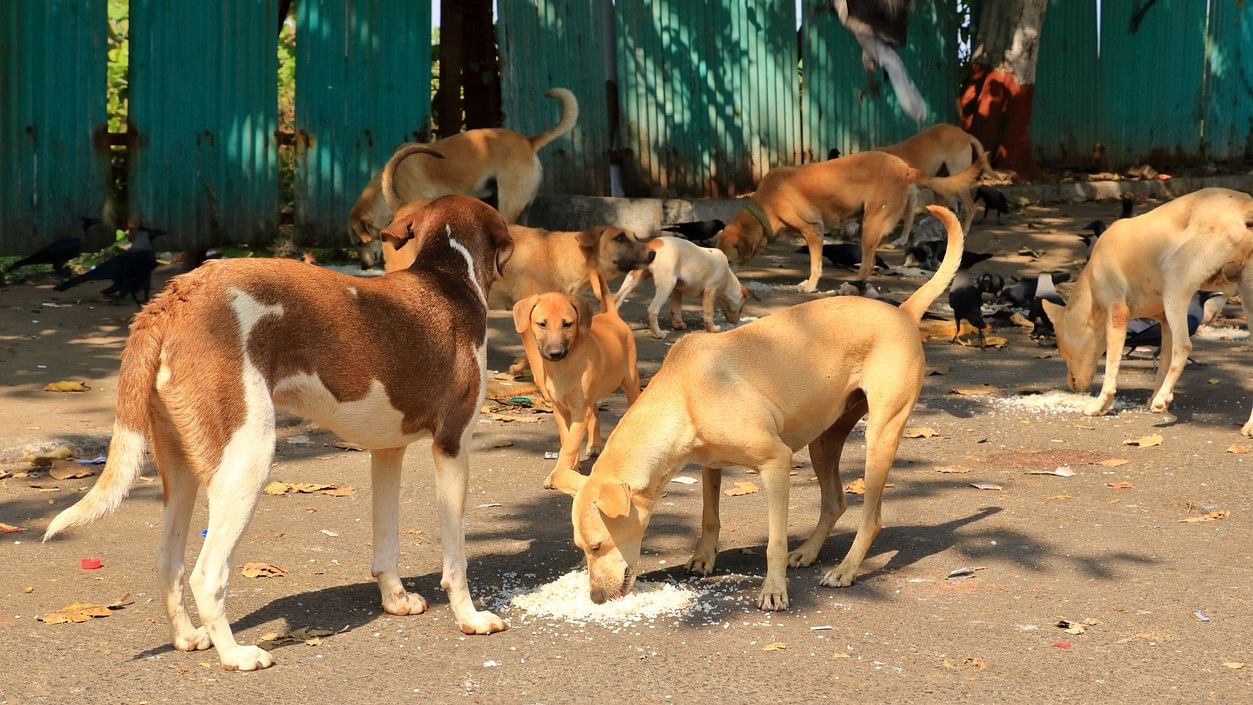
Representative image showing stray dogs.
Credit: iStock Photo
The old journalism maxim, “If a dog bites a man, it is not news; but if a man bites a dog, it is,” has taken an ironic turn in recent months as incidents of dogs biting humans make headlines across India. Stray dog bites and mauling of both children and adults have become disturbingly regular, prompting concerns and anger among citizens.
In mid-October, the death of Parag Desai, the executive director of Wagh Bakri Tea Group, after a fall while trying to ward off stray dogs, made headlines across the country. In the same month, an eight-year-old girl on her way to a grocery near Agra was attacked by stray dogs. Two weeks later, she died.
In April, a retired doctor was attacked and killed by a pack of stray dogs during his morning walk inside the Aligarh University campus. The incident captured on CCTV was shared widely on social media.
Still vivid in memory is the gruesome Hyderabad incident in February, when a four-year-old boy was mauled and killed by stray dogs. The graphic video footage went viral, provoking outrage on social media and sparking discussions on the dangers that stray animals pose.
The rising cases have caused immense concern and anger among people who want a quick fix to the canine attacks.
Even the Chief Justice of India, D Y Chandrachud and a few other Supreme Court judges expressed concerns on the issue after seeing a lawyer bandaged due to a dog attack.
A few months earlier, the SC emphasised the need for a solution to the enduring problem of stray dogs in India while hearing a petition filed by the Kerala State Commission for Protection of Child Rights.
Incidentally, Kerala is among the top six states in India when it comes to dog bite cases. Last year, the state saw 1.9 lakh cases of dog bites, with 21 deaths due to rabies, media reports said.
India has about 62 million stray dogs, according to the State of Pet Homelessness Index 2021 by Mars Petcare, the global pet health and nutrition company.
Cases of deaths caused by stray dog bites are shockingly high in India. Every year, over 55,000 people are killed by dog attacks globally, with India accounting for 36% of the global deaths due to rabies and 65% of the deaths in the South-Asia region, according to World Health Organisation (WHO) data.
There’s no government data on the number of dog bite cases in India; however, there are about 1.74 crore dog bite cases annually, media reports said in October, citing the Association for the Prevention and Control of Rabies in India, an NGO. A number of cases go largely unreported,especially in rural areas.
Chilling statistics indeed. Given how widespread the menace is, the issue needs to be tackled on a war footing.
How does one find a viable solution when, on the one hand, troubled citizens vociferously demand an end to the stray dogs’ problem while, on the other, animal activists humanely plead for mercy towards man’s best friend?
There are many solutions that are sustainable, practical, and humane to dogs and people, and all that is needed is determined and serious efforts on the part of the Animal Welfare Board, the local administration, stakeholders, and citizens.
The WHO guidelines and various policies formulated are crystal clear; what’s desired is immediate implementation in letter and spirit. The guidelines include enforcement of pet control laws, neutering and vaccinating pets, spaying and neutering stray dogs to reduce the street dog population, and rehabilitating stray dogs in dog sanctuaries and shelters. Dog lovers can come and visit them, bring food, or donate money to the sanctuary.
While broad policy implementation is the responsibility of the government and various organisations, creating public awareness is crucial, especially in rural and densely populated areas. Awareness campaigns, seminars, and programmes should include how to deal with stray dogs, dog bites, the dangers of rabies, medical treatment, and protecting humans from stray dogs. Dog control cells should be set up for complaints/emergencies.
A common occurrence in rural areas and cities is the practice of residents feeding stray dogs on the streets without taking any responsibility for the dogs’ health or welfare. Such dogs become semi-domesticated and territorial and frequently attack passersby and two-wheeler riders. That apart, often owners take their pet dogs, including ferocious breeds, for walks
without a leash, putting pedestrians at risk.
It is high time the authorities concerned swing into action, and strict rules must be enforced to ensure people act responsibly with pets and stray animals.
(The writer is a senior journalist)